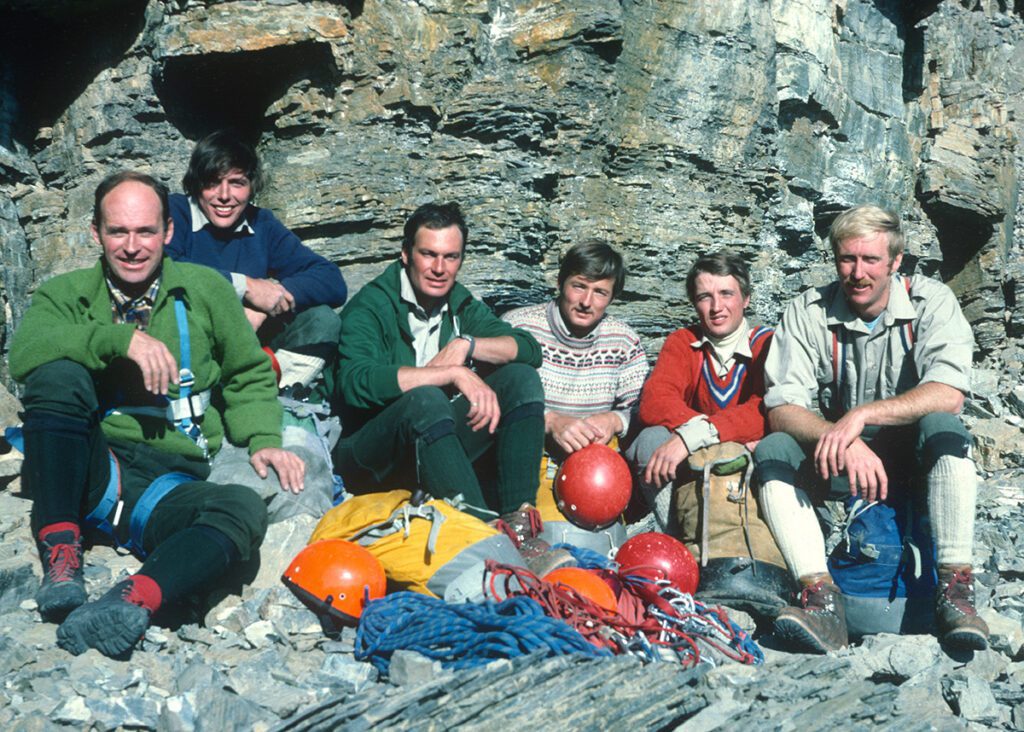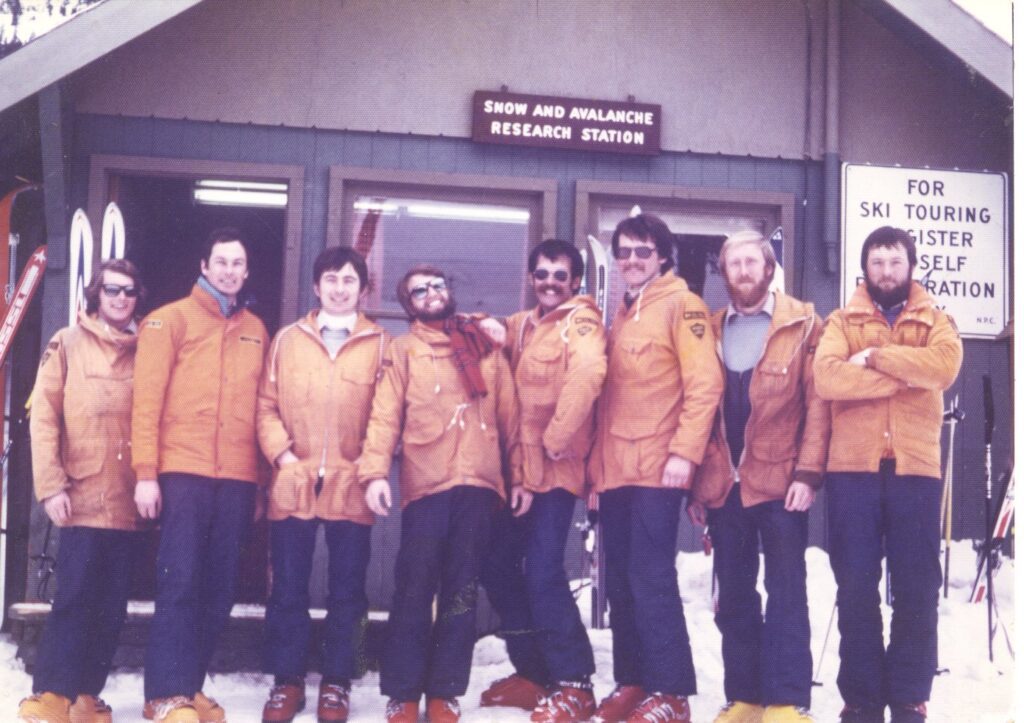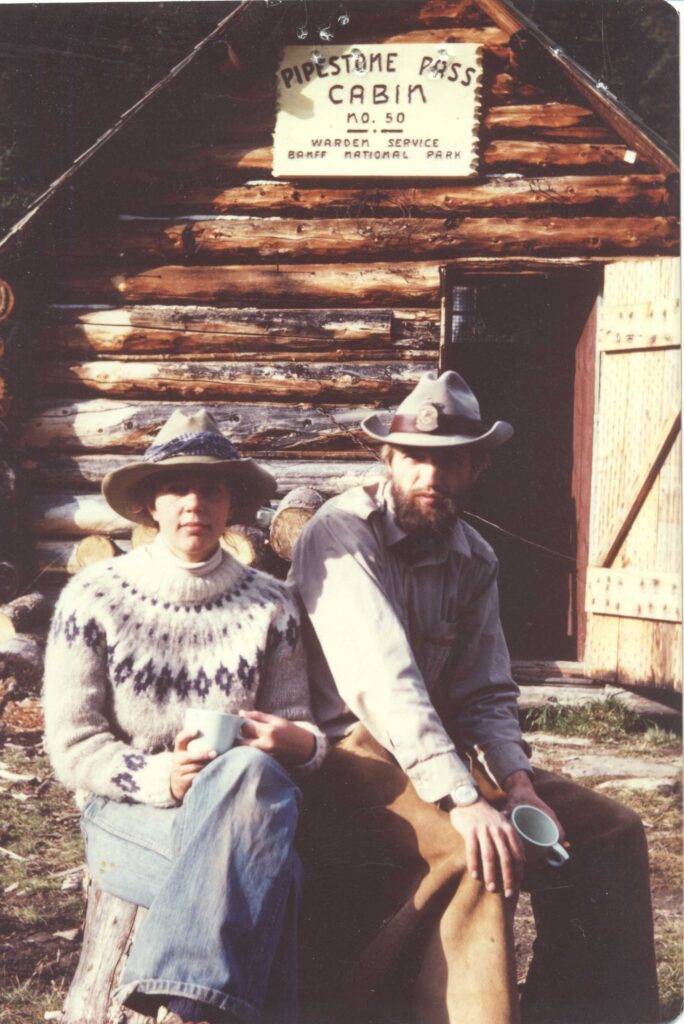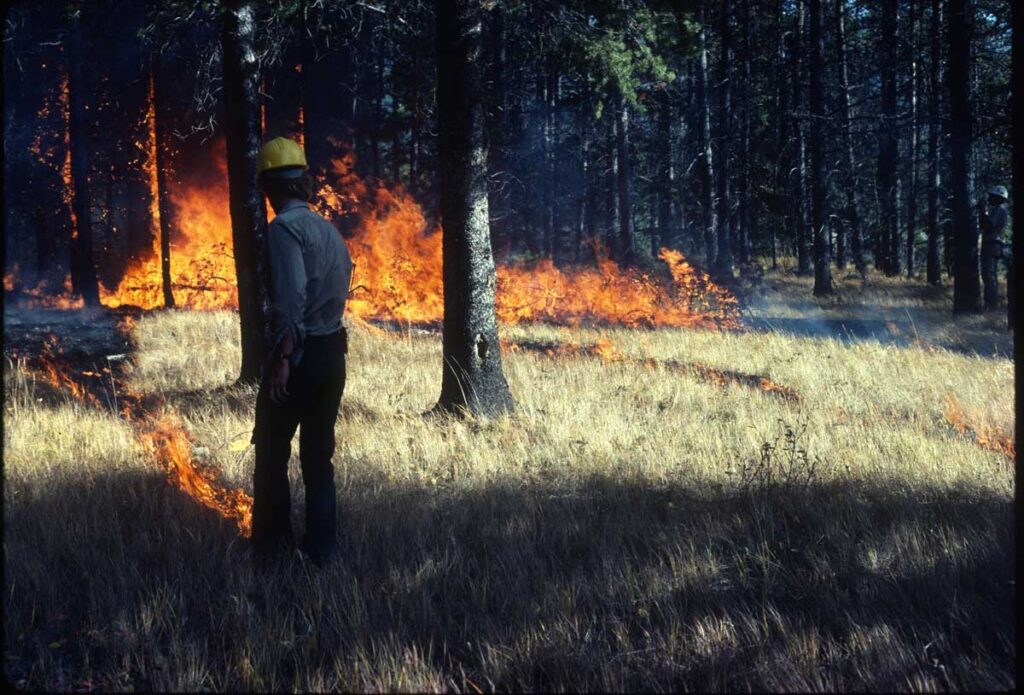Thank you to the Whyte Museum of the Canadian Rockies for granting permission to the Park Warden Service Alumni to post this interview on our website.
Park Warden Alumni Society of Alberta
Oral History Phase 10, 2020
Phone Interview with Cliff White
Date/time: April 21st, 2020/1500
Interviewed by Monique Hunkeler

2008 Divide Cabin: One of my favourite spots in the Rockies
Place and date of birth? Born April 8, 1954 in Banff, Alberta
MH: Where did you grow up?
CW: I grew up at Banff and most of my summers were at Sunshine Village ski area. My parents bought the ski hill in 1960 so from the time I was 6-18 years old, I spent every summer up at Sunshine.
MH: How did you become involved in the Warden Service? Which national park did you start working in?
CW: Well when you grew up at Sunshine you were totally mixed up with the Warden Service because when I first started there, we were on the party phone line for the Wardens, we were three longs and Healy Creek District was on a phone line below us and they were two longs and a short. So anyways you got to know who was on the party line. And there were the Hermanrude kids below us and eventually Terry Skjonsberg moved there and his mom Betty sold tickets up at Sunshine for my dad for 30-40 years, so we got to know the Skjonsberg family. Earl was the District Warden. So lots of summer trips with the Skjonsbergs to go to various Warden Cabins and then Terry and I both became wardens and were on a similar career track all of our lives.
0145: As resort owners, my dad was working full time at Sunshine and my mom worked there too for the first 10 years or so. During the winter, we would go up to Sunshine every Friday afternoon at 4:00 and spend the weekends up there because those were the busiest times. And in the summers, my folks would rent the house in Banff and move to Sunshine because it was open during the summers so we’d live right at Sunshine from the end of June until sometime in September when we came back to school in Banff.
230: I started working in Yoho in 1973 working on the fire crew working with Al McDonald. Stan Stachera was the warden in charge of our joint trail/fire crew down in Yoho and eventually I then took a year and worked on the Great Divide Trail and then came to Banff in 1975 as a seasonal warden. I more or less stayed in Banff. I worked one year in Lake Louise and then moved up to the Saskatchewan Crossing for a year. I went back to University of Montana and finished my BSc degree in Forestry and came back to Lake Louise as a full-time in warden in 1977. Later, in 1980 I moved to Banff to work on the fire and public safety programs there.
MH: What made you want to join the Warden Service? 0330:
CW: I really knew the lifestyle and just wanted to see the park very much. We knew the Healy Creek District with the Skjonsbergs and the Hermanrudes, but it was really neat to think that there were 17 or 18 other districts in Banff and some of them were way in the middle of nowhere. And my father had always wanted to be a Warden and he said as soon as he finished being a ski area manager he was going to move up in life and get to be a Warden, so he thought it was a good career opportunity and was always keen on it. And yeah it was just something you always did and a lot of kids around town and many of my friends were involved in it so it was just kind of a natural thing to do it. And through an interesting set of circumstances about 1964, me and some of my buddies got caught burning down a cabin on Sundance Creek for something to do one fall day. We got caught by George Balding who was the town Warden. In the process of dealing with this he kind of took myself along with his son Verne, same age, who got caught lighting a fire shortly thereafter. So George thought he should look after both of us quite carefully. For about a year or two, I spent a lot of time with the Baldings too as well as the Skjonsbergs. George was making sure we didn’t burn anything else down. In 1967 I went out with Verne and spent the summer in Point Pelee National Park where the Baldings had moved to when George became Chief Park Warden and then eventually Superintendent, and so saw another side of the Warden Service there. Just got to see the Parks Service a little bit more and thought this is a great way to see Banff Park and the country so became a Warden. My dad was pretty impressed after all the trouble I got in with burning that cabin down that I could go on and make a career out of lighting prescribed fires later on. He was pretty astounded!

1975 Advanced Climbing School: Peter Fuhrrmann, Tim Auger, “Tension” Traf Taylor, Clair Israelson, CW, Jim Murphy at top of Brewers Buttress

1978 “Team Temple” Warden Avalanche Control: Bill Moffat, Traf Taylor, Scott Ward, CW, Eric Langshaw, Doug Ohrn, Jim Murphy, Clair Israelson
MH: What different parks did you work in? How did they compare? Do you have a favourite? 0600:
CW: Yoho and Banff were the two parks I worked in. They were both pretty much the same. Working in the fire and rescue programs, we were back and forth to Yoho, Kootenay and Jasper frequently. For me, a main career event was going to Ottawa for about four years 1986-1990 to work as the National Fire Management Coordinator so I got to see virtually every National Park in the country that had trees. I really did get to see a whole chunk of Canada. And I saw the home life of the Wardens and worked with a lot of Wardens in those various parks. But eventually I decided that if you like the excitement and the big programs, and could use a high profile in Parks Canada and try to move a program along then Banff was definitely the place to work. We came back from Ottawa to Banff in 1990 and at that point I was really happy to see the last of the skyscrapers and Government paperwork and being on an airplane all the time. By then Johanne and I had kids, and although Johanne had a great job in Ottawa as a managing dietician at the Civic Hospital, she agreed that a town like Canmore would be good to raise our kids. Our home was close to my office in Banff, and her job at the Canmore hospital, so it was an ideal place for Charles, Peter and Alex to grow up. For me, I could get up in the morning and decide what you were going to do. If you needed to get out by helicopter, go straight to the helipad, if you wanted to ride, then stop at the barn and get a horse, or go to the office and get into your truck and out the back door and go virtually anywhere in one of the nicest parks on the planet.

1980: Jo and Cliff at Pipestone Pass Cabin

Right: 1994 Little Pipestone Cabin: Cliff White Senior, Peter White, Charles White, Alexandra White, and Johanne.
0745: In terms of lifestyle in Canmore, the community here and everything being so close–Calgary, the airport, University, good schooling in the area. Banff itself is an amazing park. It has probably the nicest backcountry of any park I’ve seen in North America, with lots of meadows, rivers and streams, and lots of open alpine area, and then there is the warden cabin system which is unbelievable. Just the history of the Banff Districts and the amount of time and money spent on the cabins to keep the backcountry system in good condition. An amazing equestrian system where the horses know exactly where they are going. All you really have to do is get on them in the morning and they’ll take you to the next cabin no problem. I thought all the way around, Banff was amazing. I was in Public Safety for the first 5-10 years, 1/3-1/2 of my time was spent doing Public Safety and Avalanche Control at the ski hills. And then just an amazing caliber of staff in Banff. If you looked at the Warden Service, it was some of the best and most driven wardens you could find who kind of fought their way through the issues and promotions and all the issues just to get to Banff. We had the best superintendents in the system, they almost always got rotated through Banff so you really had a great cast of characters. And if you liked Ottawa folks, they were only one or two phone calls away and they liked to talk to you to see what was going on in their busiest park.
MH: What were some of your main responsibilities over the years? 0940:
CW: I was a standard generalist warden when I started. In those days you started off and your main responsibilities would start off being Law Enforcement or frontcountry and patrolling. Backcountry was another assignment you had to take on for several long trips by horse every year. Public Safety in Banff was a big issue so you had to keep up your mountaineering skills, and then the role of Resource Management began to increase. These were the rotation of responsibilities that you started off in in Banff, and each of them took a full year to master so it took about 3-4 years, spending a year in each one of those to feel comfortable in what you were doing. In the late 60s after the district system ended, Banff experimented with, depending on your job, a 2-4-week rotation between some of those tasks. By the mid 1970s or 1980s it became more of a 2-3-year rotation in a Resource Management job or Law Enforcement job, but the jobs were always quite good. I liked all of them when I started. I particularly liked the backcountry and I really liked Public Safety so it was really a lot of fun for that first decade or so. Usually worked 2-3 days in Public Safety in the winter, mostly Avalanche Control at one of the ski hills. You got to work with a really neat bunch of people in Public Safety like Clair Israelson and Tim Auger, and when you got burnt out on that, you could be working on a resource management project and then in the fall it was boundary patrol season so out in the backcountry with the horses. They were all pretty good jobs.
1150: In the early 80s I went back for a Master’s degree at Colorado State University at Fort Collins and in those days, it was a big deal to go back to school. They said, “Well you have a fulltime job, you’re doing pretty good in Public Safety, why do you want to go back to school?” but I thought eventually I would like to not just be a field level warden, I wouldn’t mind getting more education and so when I applied for leave – even Leave without Pay, they said “well no, you are supposed to come back to work on September 1st, so if you disappear, you’re going to lose your job.” I had partial funding to go back to school in Fort Collins to do my master’s degree so I said, “I think I’m going to do this and would like to work with Parks Canada in the Fire Management Program when I complete my Masters.” After being gone for a month, I got this letter that said, “it would be a detriment to the Warden Service if you left to go back to school”. I couldn’t believe it, but I was now officially AWOL (away without leave). Luckily, management reconsidered about a month later, I received a letter that said ”Okay we are giving you leave without pay for school” After Christmas, I received another letter saying, “we’re beginning to think this fire management might be a good thing so we’ll start to pay you”, and by the end of my term, I went straight back to work and had a great job! I was Public Safety in the summer 1-2 days/week filling in for Tim Auger on his days off, and then I did Fire Resource Management work the rest of the time working on a Fire Plan for Banff Park and started doing prescribed burning. Then in the winter I would work about 4 days a week at Norquay Ski Area as the Avalanche Control Warden there until 1986 and while I was up there on quiet days (there were a lot of those days at Norquay in those days because we didn’t get much snow). I’d work on my Master’s degree and wrote my thesis in the cabin there. I don’t think anyone ever had a nicer place to write a Master’s Degree. When you had writer’s block, you simply stepped outside and went for a ski. Couldn’t beat that .

1983-09-29 Two Jack 1: Our first prescribed burn. Over 15 trees may have been scorched.

1985: Mark Heathcott lighting up the west slopes of the Palliser Range. Over 500 ha of trees were more than just scorched.

1988 Lake Minnewanka Prescribed Fire: Serious spring time lodgepole pine burning.
1413: When I finished my Master’s Degree, I probably wasn’t in Banff for more than a year and they said, “Okay why don’t you come down to Ottawa and work here.” Johanne and I just got married, and her family lived out east, so this worked well for her. I went down there for a 4-year gig to work with Dave Lohnes and Nik Lopoukhine in Ottawa to set up a National Fire Management System. I tried to model a national program based on what we had tried in Banff (prescribed burns, research, organizing crews) and what the provinces were doing. My big job in Ottawa was to create a total mobility system so that we could rapidly get staff moving from place to place during bad fire years, and get people sharing experience so that if you worked on a prescribed burn in Banff, you could easily go to another Park and help them do a prescribed burn. Stephen Woodley came into the Ottawa job after me and closed the deal. Within about 5 years, we had prescribed burns going from coast to coast with a highly mobile group of people. A lot of the experience that we picked up from was from Public Safety in terms of avalanche control, using weather and helicopters. People like Jim Davies and Lance Cooper brought on use of the first aerial ignition systems in Parks Canada because they were used to slinging and doing eloquent work with helicopters. It didn’t take long for us to become a very air mobile and professional group just because of this background from Public Safety. Keith Everts was really key in that because he understood weather forecasting. By then he was working as Assistant Chief Park Warden for Resource Management in Banff but he had extensive avalanche control experience so he was very quick at moving the weather monitoring programs over to doing fire and prescribed burns. If you can throw bombs out of a helicopter for avalanche control, you can probably light up a bit of a forest too and not burn the park down. It all came together fairly well.
1618: Before I left for Ottawa, there had been this undercurrent about the need to professionalize the Warden Service and specialize more. As early as 1976 we had a major Labour Management Committee in Banff and the main issue of the day was that all the Wardens were classified the same but for Public Safety, there was a real need to ensure that people like Tim Auger and Clair Israelson had designated positions because we really needed those skills to run rescues. We couldn’t rotate people all the time, they needed specialists in those roles and Tim and Clair were the first two specialized wardens in Canada to get reclassified as GT-3 Public Safety Wardens. That then moved along a bit later in Banff, and by 1979 Perry Jacobsen had the first specialized wildlife job description and then I got the first specialized vegetation management job. So those were some of the first specialty jobs that developed and generally, as much as they could, they began to adapt all the smaller parks across the system. Jasper was very parallel to Banff that system. When I came back in 1990, Bob Haney, the new chief park warden recognized that they needed to form an integrated Ecosystem Management shop. By this point we had folks with Masters degrees vying for jobs in wildlife and vegetation and we were going to get an Aquatics specialist, Geographical Information System specialist and a whole host of other staff, so Banff Park management agreed the resource specialists would generally be a masters level job, and there would be Assistant Chief Park Warden for Ecosystem Management. When I came back to Banff in 1990 I was offered the job on an interim basis, and over the next few years they finally set it up as a full-time job at the Masters or PhD level. For a big park like Banff, the real advantage in this organization was that it was semi-separate from day to day operations like dealing with public safety, problem wildlife, or law enforcement occurrences. This allowed the wardens in our ecosystem group to fully work with students, universities and other agencies that needed us on a predicable schedule for meetings, research projects, cooperative landscape management, and conferences etc. Our group was stable for nearly 20 years with Tom Hurd doing wildlife, Ian Pengelly on the fire/veg program, Charlie Pacas as the aquatics specialist, and Dave Gilbride doing GIS, and later with Darrel Zell took Dave’s place, and Heather Dempsey and Mary Dalman were our outreach and interpretation specialists. We rotated wardens though the tech jobs, and at our peak had over 50 masters and doctoral students, and their associated techs all doing project work in the park or adjacent areas. One year we served over 100 steaks at the summer’s-end bash at Castle Camp. Our research project budget was over a million dollars for several years, with a ton of additional matching money coming in from other sources. Luckily, in those days we had great support for research from Nik and Stephen in Ottawa, and the Banff Superintendent and Assistant Supts.’ offices…folks like Charlie Zinkan, Jillian Roulet, Bill Fisher and Dave Dalman did what they could to keep the science program “on the straight and narrow” even though processes like the Banff Bow Valley Study certainly had their heavy politics.



